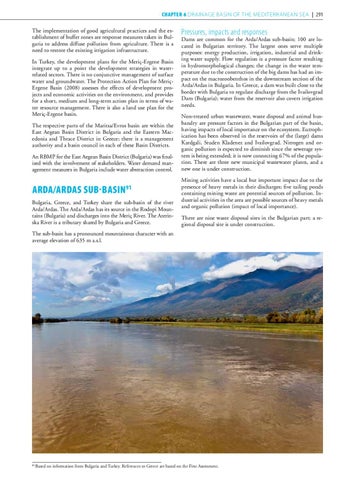Chapter 6 DRAINAGE BASIN OF THE MEDITERRANEAN SEA | 291 The implementation of good agricultural practices and the establishment of buffer zones are response measures taken in Bulgaria to address diffuse pollution from agriculture. There is a need to restore the existing irrigation infrastructure. In Turkey, the development plans for the Meriç-Ergene Basin integrate up to a point the development strategies in waterrelated sectors. There is no conjunctive management of surface water and groundwater. The Protection Action Plan for MeriçErgene Basin (2008) assesses the effects of development projects and economic activities on the environment, and provides for a short, medium and long-term action plan in terms of water resource management. There is also a land use plan for the Meriç-Ergene basin. The respective parts of the Maritsa/Evros basin are within the East Aegean Basin District in Bulgaria and the Eastern Macedonia and Thrace District in Greece; there is a management authority and a basin council in each of these Basin Districts. An RBMP for the East Aegean Basin District (Bulgaria) was finalized with the involvement of stakeholders. Water demand management measures in Bulgaria include water abstraction control.
Arda/Ardas Sub-basin91 Bulgaria, Greece, and Turkey share the sub-basin of the river Arda/Ardas. The Arda/Ardas has its source in the Rodopi Mountains (Bulgaria) and discharges into the Meriç River. The Aterinska River is a tributary shared by Bulgaria and Greece.
Pressures, impacts and responses
Dams are common for the Arda/Ardas sub-basin; 100 are located in Bulgarian territory. The largest ones serve multiple purposes: energy production, irrigation, industrial and drinking water supply. Flow regulation is a pressure factor resulting in hydromorphological changes; the change in the water temperature due to the construction of the big dams has had an impact on the macrozoobenthos in the downstream section of the Arda/Ardas in Bulgaria. In Greece, a dam was built close to the border with Bulgaria to regulate discharge from the Ivailovgrad Dam (Bulgaria); water from the reservoir also covers irrigation needs. Non-treated urban wastewater, waste disposal and animal husbandry are pressure factors in the Bulgarian part of the basin, having impacts of local importance on the ecosystem. Eutrophication has been observed in the reservoirs of the (large) dams Kardgali, Studen Kladenez and Ivailovgrad. Nitrogen and organic pollution is expected to diminish since the sewerage system is being extended; it is now connecting 67% of the population. There are three new municipal wastewater plants, and a new one is under construction. Mining activities have a local but important impact due to the presence of heavy metals in their discharges; five tailing ponds containing mining waste are potential sources of pollution. Industrial activities in the area are possible sources of heavy metals and organic pollution (impact of local importance). There are nine waste disposal sites in the Bulgarian part; a regional disposal site is under construction.
The sub-basin has a pronounced mountainous character with an average elevation of 635 m a.s.l.
91
Based on information from Bulgaria and Turkey. References to Greece are based on the First Assessment.
